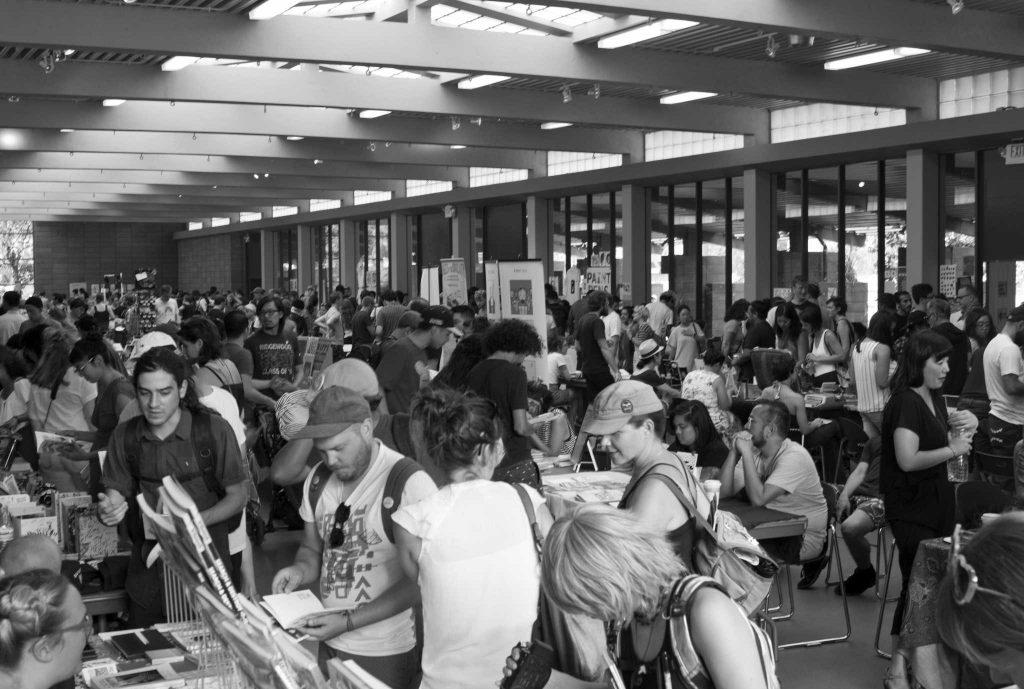As a record-breaking heatwave blitzed San Francisco over Labor Day weekend, more than 400 “zinesters” filled the non-air conditioned County Fair Building in Golden Gate Park for a Sunday zine fest.
A Zine — short for fanzine — is traditionally a “cheaply-made, cheaply-priced publication, often in black and white, which is mass-produced via photocopier and bound with staples,” according to Urban Dictionary.
“For me a zine is empowerment,” said Connor Burbridge, 22. “It empowers your own experience by saying ‘I matter, my experience matters, and I think it’s worth sharing with other people.’”
Founded in 2001, the 16th annual San Francisco Zine Fest is Northern California’s oldest and largest do-it-yourself publishing festival. Over 200 unique vendors displayed and sold graphic novels, comics, stencil art, patches, newspapers, on-site tattoos, as well as the more traditional stapled black and white zines.
As the doors opened at 11 a.m., zinesters continuously flowed in until it was a standing-room-only crowd. Basic zines were selling for 50 cents while the fancier bounded ones were as high as $20. Zine trading was also common during the festival, as new friends swapped intimate stories.
Burbridge hitchhiked west from Atlantic City, New Jersey to attend the zinefest with his own homemade zines in-hand to distribute to attendees. He says the event is renowned for being a special sort of zine fest.
“There’s nothing like this on the East Coast yet…I see so many young people out here from every type of scene, from hippies to punks, hipper people and older people,” he said.
Maira McDermott is one-third of an Oakland-based group of zine publishers that go by the name Queer Anxiety Babiez Distro. The collective’s Facebook page describes them as “three anxious nonbinary cuties making zines, patches, buttons, and general good vibes.”
This year’s zine fest was their third in San Francisco and 20th zine fest over all. Their zines generally center upon the intersections of gender and mental health. For McDermott, making zines is therapy.
“A joke I normally make is that it’s cheaper than therapy,” they said
The San Francisco Zine Fest is a year-long planning venture accomplished by a small handful of volunteers eager to spread their love of the craft.
Volunteers like Executive Director Channing Kennedy, 37, felt drawn to zine culture immediately after being introduced to it.
“The first time I came to a zine fest it just felt like home, it was just a bunch of weirdos doing whatever they felt like, “ he said.
Kennedy has been volunteering at the San Francisco Zine Fest since 2009 and says it’s evolved quite a bit since he began working the event.
“The last few years we’ve put concrete policies into place as a festival to include more groups of people who were not previously represented in the zine community,” he said. “In the last few years we’ve seen more people of color and more people with disabilities.”
Policies like this year’s Safer Spaces Policy are among newer inclusionary measures festival organizers have implemented to open up zine culture to as many people as possible.
“Zines right now exist as a way to communicate and show solidarity with each other, from people in the same groups or across groups that may experience different forms of oppression,” said Kennedy.
The policy promotes a harassment free experience “regardless of gender, gender identity/expression, sexual orientation, disability, physical appearance, body size, race, or religion.”
The San Francisco Zine Fest wrapped up promptly at 6 p.m. a packed house gasped aloud Nobody wanted to leave, but then again there’s always next year.
“People say zines are dead but this is just evidence their not dead at all,” said Burbridge.





